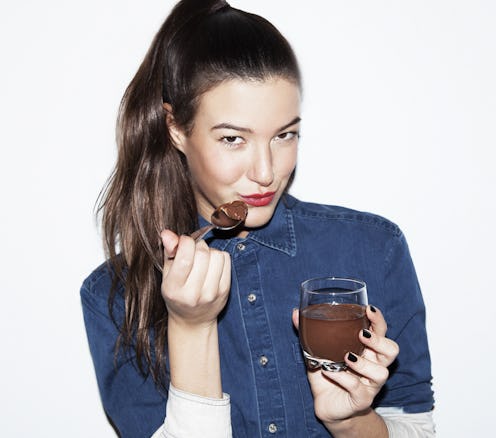Food is an amazing substance that fuels our bodies, and it tastes pretty freaking great. But when you’re trying to improve your eating habits, wading through all the information out there can be overwhelming. Are carbs good or bad? Gluten or no gluten? Since everyone on the Internet has an opinion, we decided to go to the actual experts to see what they have to say about today’s trending diets—the Master Cleanses of 2017, if you will. Here, the pros and cons of each.
The Truth About These Trendy Diets
Gluten-Free
What it is: Gluten is a name for the proteins found in wheat, barley and rye. Some people are allergic or have an intolerance to it, which is called celiac disease, wheat allergy or non-celiac gluten sensitivity. Some people think they're allergic to it, which is called living in Los Angeles (kidding-ish!). You can test negative for celiac and still have a gluten sensitivity, but the only way to find out is by elimination.
Proponents of the gluten-free lifestyle say it can decrease anxiety, improve your skin, help you lose weight, clear mental fog, nix bloating and other digestion issues—basically, it’s Windex of diets.
The pros: “The gluten-free diet is a medical necessity for anyone with celiac disease or gluten sensitivity. It can greatly improve their quality of life,” says Emily Kyle, MS, RDN, owner of Emily Kyle Nutrition.
The cons: If you don't have celiac or an intolerance, there's really no reason to eliminate gluten. "I look at the gluten-free fad like the fat-free craze years ago. Not everyone needs to go gluten free!” says dietitian and nutritionist Jenny Beth Kroplin, RD. "If we are eating mindfully in moderation, foods that have gluten are just fine, and many of those foods provide great energy and nutrients we need."
It can also be tempting to overindulge on gluten-free sweets and bread because they seem healthier (they're not). The GF on the label is not a harbinger of health. In fact, sometimes gluten-free treats contain more sugar and fat than their non-gluten counterparts.
Vegan
What it is: The vegan diet consists of plant-derived products like grains, fruits, veggies and nuts—no meat, no fish, no eggs, no butter, no honey. Many people choose it for environmental and ethical reasons; others for health benefits like a lower body fat percentage and more energy.
The pros: A vegan diet can give you tons of antioxidants and phytonutrients, which Kroplin says can help ward off disease. She also notes it can reduce high cholesterol and high blood pressure.
The cons: "This diet approach takes very careful planning to ensure a daily balance, since you can risk not fulfilling the micronutrients needed for the body," she says. These include iron and B vitamins, which are found in meat.
Like with the gluten-free diet, you don’t want to always equate vegan with healthy. (After all, Oreos are technically vegan.)
Paleo
What it is: A diet more divisive than GOOP’s Sex issue—people have opinions about it. Depending on who you talk to, it's either life-changing or totally ridiculous. On it, you'll eat veggies, meat, fruit and nuts—no grains, dairy or legumes. Carbs come from foods like sweet potatoes. Over the past few years, this diet has become increasingly popular for weight loss.
The pros: "The Paleo diet focuses on whole food in the form of fruits, vegetables, nuts and lean meat and discourages the consumption of processed foods, which is a great pro for so many," says Kyle. These foods can help reduce inflammation in the body, adds Kroplin. Despite these benefits, they agree there are a couple drawbacks.
The cons: "In a nutshell, the con for Paleo is that it excludes some major food groups that provide big time nutrition our body needs," says Kroplin. These include grains, a source of energy for the body, and fiber-rich beans and legumes.
Also, speaking from experience, you'll consider cauliflower crust pizza a splurge.
Counting Macronutrients
What it is: Macronutrients are nutrients we need to consume in large quantities; the three macronutrients are protein, fat and carbs. Counting your macros means you set a daily goal for each of the three and then track what you eat throughout the day to ensure you don't over or under eat.
The pros: "Being more aware of the food we eat is always beneficial and helps us make better choices," says Kyle.
"This approach doesn't eliminate food groups, which is a positive," adds Kroplin. "It encourages balance and variety, providing a diverse nutrient profile for the body." It can also be tailored to your specific needs. (Find more details here.)
The cons: Theoretically, you could eat Cheez-Its and cupcakes all day as long if it fits with your macronutrient goals. Be sure to take into account the quality of your food (like vitamins, minerals, amino acids), as well as your micronutrients.
Kroplin also cautions that counting systems can lead to burnout in the long run.
Ketogenic
What it is: A low-carb, high-fat diet. The carb reduction puts you in ketosis, a metabolic state in which your body burns fat for energy instead of carbs. Sounds great, minus the no-eating-carbs part.
The pros: "New studies show it may help with weight loss," says Kyle.
The cons: One major drawback is that it's so restrictive it may be unsustainable for many people.
It's also not a balanced diet in terms of micro- and macronutrients, says Kroplin, and the high-fat, low-carb approach could cause negative effects on the body in the long term. (Also, we imagine the carb withdrawals are awful.)
